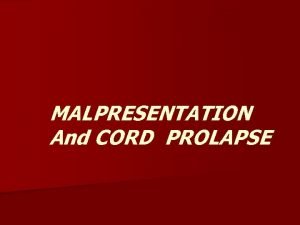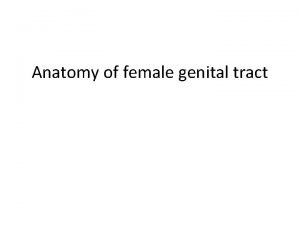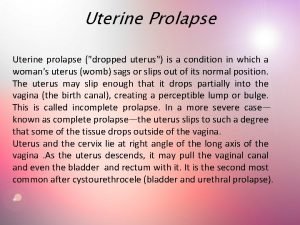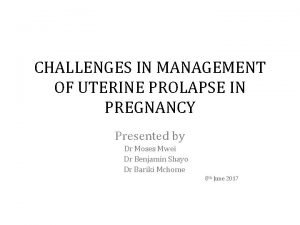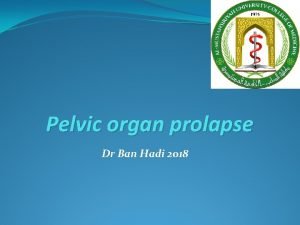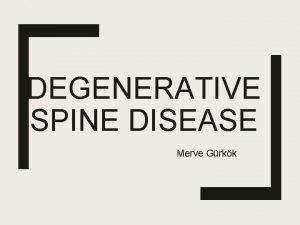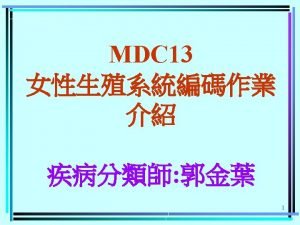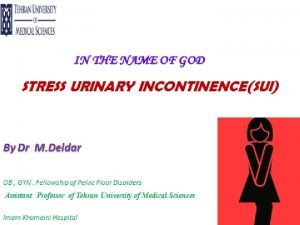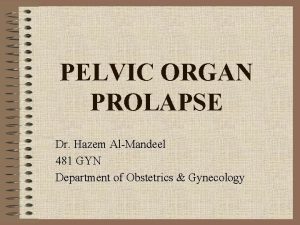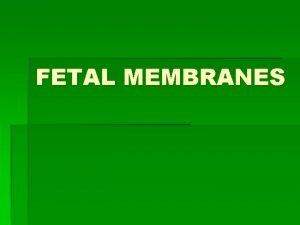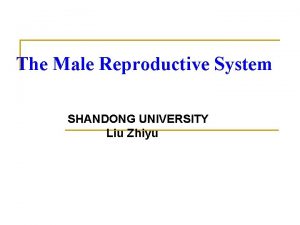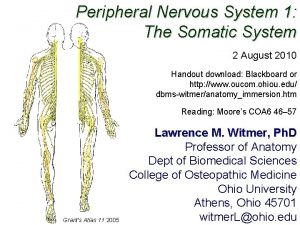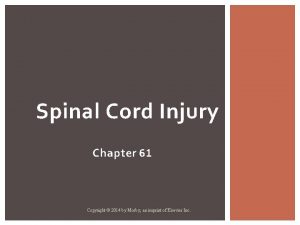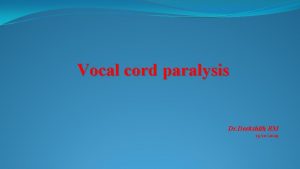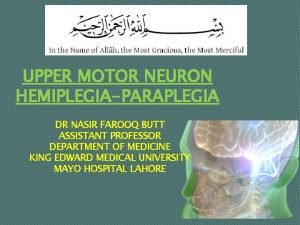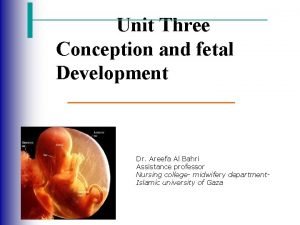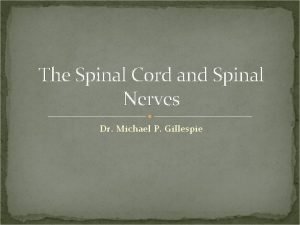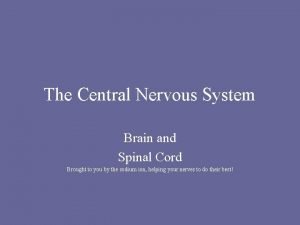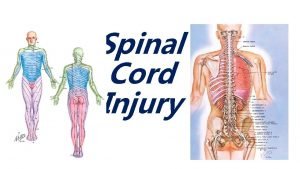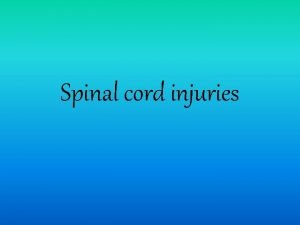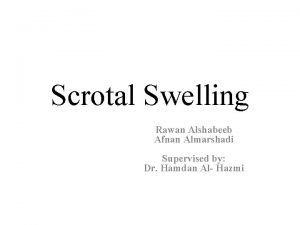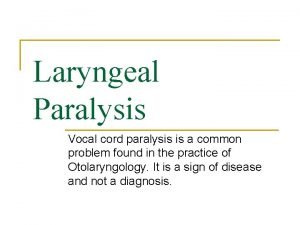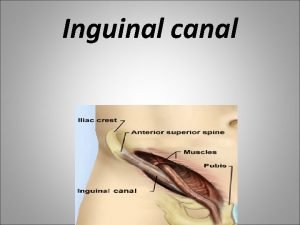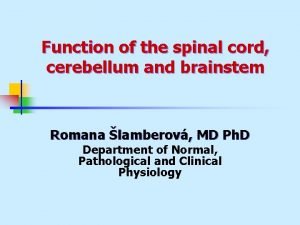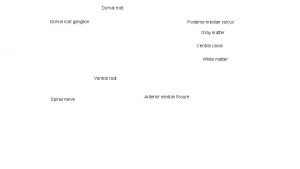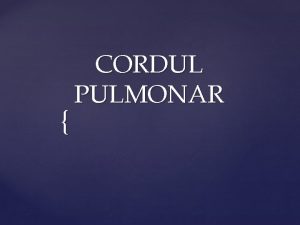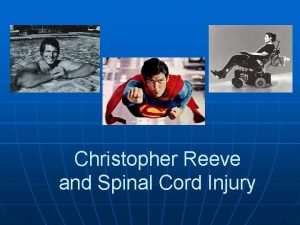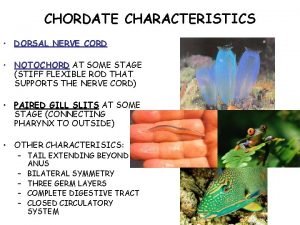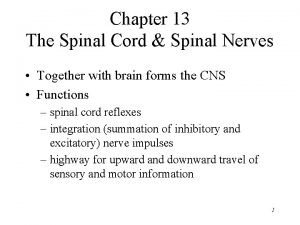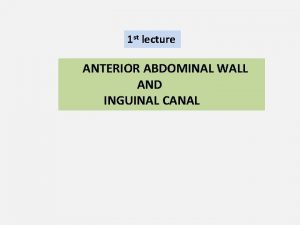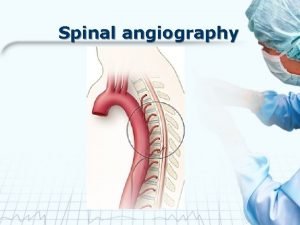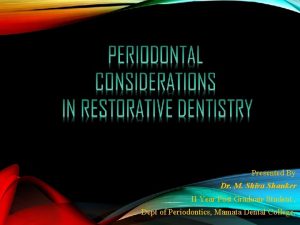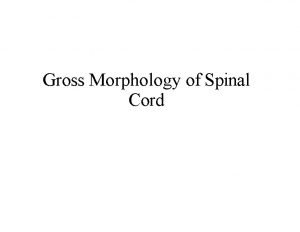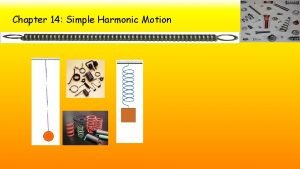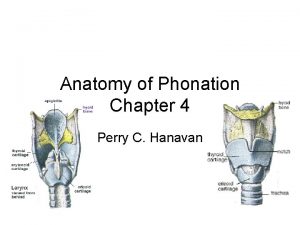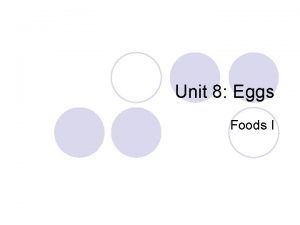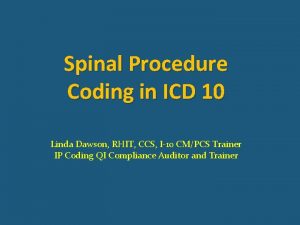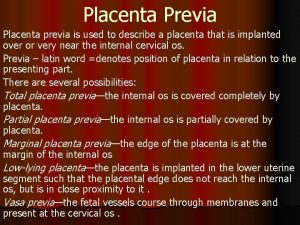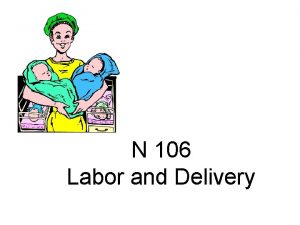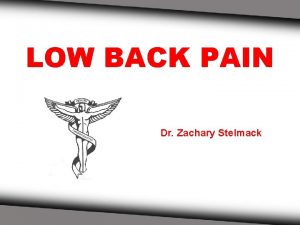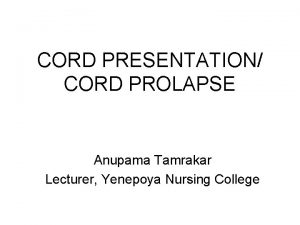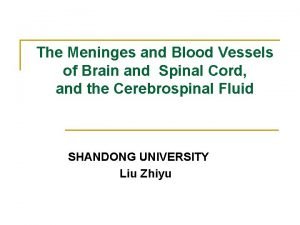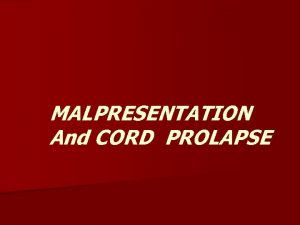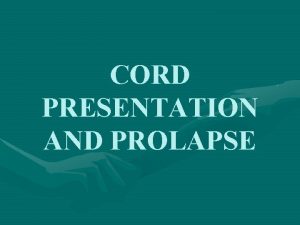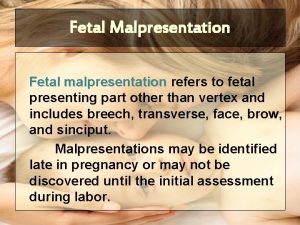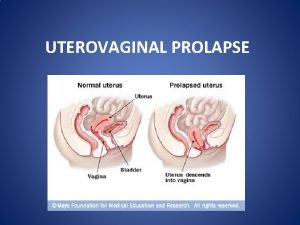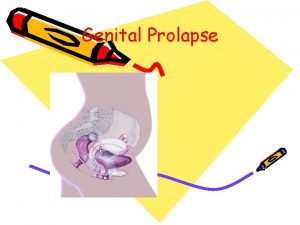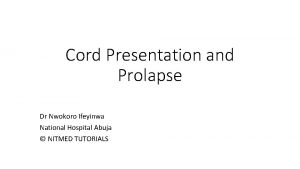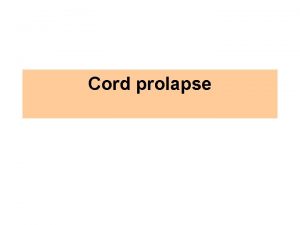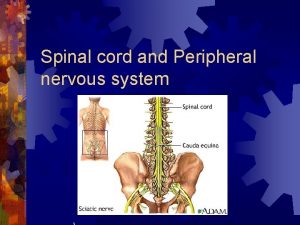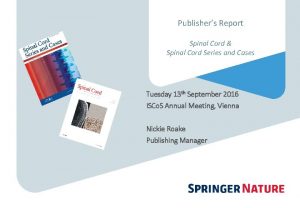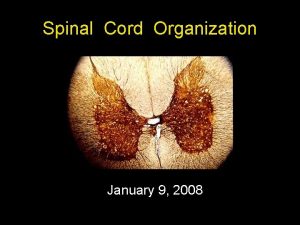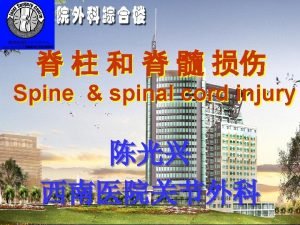MALPRESENTATION And CORD PROLAPSE MALPRESENTATION n Malpresentation is
















































































- Slides: 80

MALPRESENTATION And CORD PROLAPSE

MALPRESENTATION n. Malpresentation is the situation where a fetus within the uterus is in any position that is not cephalic





Etiologic factors in malpresentation n Maternal Great parity Pelvic tumors Pelvic contracture Uterine malformation Fetal Prematurity Multiple gestation Hydramnios Macrosomia Hydrocephaly Trisomies Anencephaly Myotonic dystrophy Placenta previa n

Breech Presentation

Introduction Breech presentation occurs in 3 -4% of all deliveries. The occurrence of breech presentation decreases with advancing gestational age. Breech presentation occurs in 25% of births that occur before 28 weeks’ gestation, in 7% of births that occur at 32 weeks, and 1 -3% of births that occur at term. . Perinatal mortality is increased 2 - to 4 -fold with breech presentation, regardless of the mode of delivery. Deaths most often are associated with malformations,

Predisposing factors n prematurity, uterine abnormalities (eg, malformations, fibroids), fetal abnormalities (eg, CNS malformations, neck masses, aneuploidy), and multiple gestations. AF abnormality. Abnormal placentation. Contracted pelvis. MG. Pelvic tumor.

n Perinatal mortality is increased 2 - to 4 -fold with breech presentation, regardless of the mode of delivery. n Congenital malformation 6%

Types of breeches n Frank breech (50 -70%) - Hips flexed, knees extended n Complete breech (5 -10%) - Hips flexed, knees flexed n Footling or incomplete (10 -30%) - One or both hips extended, foot presenting



position SA, SP, LST, RST LSP, RSP. LSA, RSA



STATION

DIAGNOSIS n. Palpations and ballottement n. Pelvic exam n. X-ray studies n. Ultrasound

MANAGEMENT n. Antepartum n. During labor n. Delivery


Criteria for VD or. CS n VD Frank GA>34 w FW=2000 -3500 gr Adequate pelvis Flexed head Nonviable fetus No indication Good progress labor n CS FW<1500 or> 3500 gr Footling Small pelvis Deflexed head Arrest of labor GA 24 -34 w Elderly PG Inf or poor history Fetal distress

VAGINAL BREECH DELIVERY n. Three types of vaginal breech deliveries: 1. Spontaneous breech delivery 2. Assisted breech delivery 3. Total breech extraction

Footling breech presentation : Once the feet have delivered, there . may be temptation to pull on the feet. However, this should never be done with a singleton gestation because it may precipitate an entrapped head in an incompletely dilated cervix or it may precipitate nuchal arms. As long as the fetal heart rate is stable and no physical evidence of a prolapsed cord exists, expectant management may be followed, awaiting full cervical dilatation.

Assisted vaginal breech delivery n Thick meconium passage is common as the breech is squeezed through the birth canal. This usually is not associated with meconium aspiration because the meconium passes out of the vagina and does not mix with the amniotic fluid.

n Picture 3. Assisted vaginal breech delivery: The Ritgen maneuver is applied to take pressure off the perineum during vaginal delivery. Episiotomies often are cut for assisted vaginal breech deliveries, even in multiparous women, to prevent soft-tissue dystocia.

n Picture 4. Assisted vaginal breech delivery: No downward or outward traction is applied to the fetus until the umbilicus has been reached.

Picture 5. Assisted vaginal breech delivery: With a towel wrapped around the fetal hips, gentle downward and outward traction is applied in conjunction with maternal expulsive efforts until the scapula is reached. An assistant should be applying gentle fundal pressure to keep the fetal head flexed.

Picture 6. Assisted vaginal breech delivery: After the scapula is reached, the fetus should be rotated 90° in order to delivery the anterior arm.

Picture 7. Assisted vaginal breech delivery: The anterior arm is followed to the elbow, and the arm is swept out of the vagina.

Picture 8. Assisted vaginal breech delivery: The fetus is rotated 180°, and the contralateral arm is delivered in a similar manner as the first. The infant is then rotated 90° to the back-up position in preparation for delivery of the head.

Picture 9. Assisted vaginal breech delivery: The fetal head is maintained in a flexed position by using the Mauriceau-Smellie. Veit maneuver, which is performed by placing the index and middle fingers over the maxillary prominence on either side of the nose. The fetal body is supported in a neutral position with care to not overextend the neck.

Picture 10. Piper forceps application: Pipers are specialized forceps used only for the aftercoming head of a breech presentation. They are used to keep the head flexed during extraction of the fetal head. An assistant is needed to hold the infant while the operator gets on one knee to apply the forceps from below.

Picture 11. Assisted vaginal breech delivery: Low 1 -minute Apgar scores are not uncommon after a vaginal breech delivery. A pediatrician should be present for the delivery in the event that neonatal resuscitation is needed.

Picture 12. Assisted vaginal breech delivery - The neonate after birth

Risks n. Lower Apgar scors n. An entrapped head n. Nuchal arms , n. Cervical spine injury n. Cord prolapse

PROGNOSIS

Table 1. Zatuchni-Andros Breech Scoring Add 0 Points Add 1 Point Add 2 Points 0 1 2 39+ 38 <37 EFW (lb) 8 7 -8 <7 Previous breech 0 1 2 Dilatation 2 3 4 Station -3 -2 -1 Parity Gestational age (wk) If the score is 0 -4, cesarean delivery is recommended

VERSION n. External n. Internal




Internal podalic version

COMPOUND PRESENTATION

COMPLICATION SD n. Immediate neonatal; birth asphyxia , traumatic injury n. Maternal; PPH, lacerations

SHOULDER DYSTOCIA (Sh. D)

Shoulder dystocia will still the obstetric nightmare

Definition: Shoulder dystocia (Sh. D) is the inability to deliver the fetal shoulders after delivery of the head, without the aid of specific maneuvers (ie. other than gentle downward traction on the head).

Definition Objective definition : Mean head-to-body delivery time > 60 seconds

PATHOPHYSIOLOGY Shoulder dystocia results from a size discrepancy between the fetal shoulders and the pelvic inlet when: The bisacromial diameter is large relative to the biparietal diameter 2. Pelvic prim is flat rather than gynecoid 1. .

SHOULDER DYSTOCIA n 0. 15 -1. 7%, n Risk factor; macrosomia, diabetes, histo ry of SD, prolonged 2 th stage of labor, maternal obesity, multiparity, postterm. n 50%SDnorisk factor n Sono


Release techniques Complications of Sh D 1. Maternal 2. Fetal

Maternal Complications (25%) 1. Postpartum hemorrhage 11% 2. Vaginal laceration 19% 3. Perineal tears 2 nd&3 rd 4% 4. Cervical laceration 2%

Fetal. Release techniques Complications of Sh D

Fetal Complications of Sh D Brachial plexus injuries, Fractures of the humerus, and Fractures of the clavicle are the most commonly reported injuries associated with shoulder dystocia

Fetal Complications of Sh D Traction combined with fundal pressure has been associated with a high rate of brachial plexus injuries and fractures

Fetal Complications of Sh D Fewer than 10% of deliveries complicated by shoulder dystocia will result in a persistent brachial plexus injury.

Fetal Complications Release techniques Head –shoulder interval > 7 min. Brain injury (sensitivity & specificity : 70 %) n With hypoxic fetus it is much shorter

Can shoulder dystocia be predicted ?

RISK FACTORS FOR SHOULDER DYSTOCIA PRECONCEPTIONAL: 1. Maternal birth weight 2. Prior shoulder dystocia 12% 3. Prior macrosomia Pre-existing diabetes Obesity Multiparity Prior gestational diabetes Advanced maternal age 4. 5. 6. 7. 8.

RISK FACTORS FOR SHOULDER DYSTOCIA Antenatal: n Excessive maternal weight gain n Macrosomia n G. diabetes n Short stature n Post term

RISK FACTORS FOR SHOULDER DYSTOCIA Intrapartum: Protracted or arrested active phase 2. Protracted or failure of descent of head 3. Need for midpelvic assisted delivery 1.

RISK FACTORS FOR SHOULDER DYSTOCIA Most of the prenatal and antenatal risk factor are interrelated with fetal macrosomia. So the main risk factor is: Fetal Macrosomia

MANAGEMENT (Within 5 - 7 minutes).

Management 1 -Suprapubic pressure 2 -Mc. Robert manoeuver 3 - Woods corkscrew. 4 -Rubens manoeuver 5 -Delivery of P. shoulder 6 -Zavanelli 7 -All fours 8 -Cleidotomy 9 -symphysiotomy

ACOG Issues Guidelines Recommendation 1991 1 -Call for help: assistants, anesthesiologist 2 -Initial gentle attempt of traction. 3 -Generous episiotomy. 4 -Suprapubic pressure.

ACOG Issues Guidelines Recommendation 1991 5 -The Mc Roberts manoeuvre (Exaggerated hyper flexion of the thighs upon the abdomen. ) & Suprapubic pressure in the direction of the Foetal face .

Mc. Roberts manoeuvre: X ray pelvimetry study No increase in pelvic dimensions. Decrease in the angle of pelvic inclination P=0. 001 Straightening of the sacrum P= 0. 04% Tends to free the impacted anterior shoulder Gherman et al Obstet Gynecol 95: 43 , 2000

ACOG Issues Guidelines Recommendation 1991 If Mc Roberts failed: 6 -Woods manoeuvre: • The hand is placed behind the posterior shoulder of the fetus. • The shoulder is rotated progressively 180 d in a corkscrew manner so that the impacted anterior shoulder is released. .

ACOG Issues Guidelines Recommendation 1991 7 -Delivery of the posterior arm : .

By inserting a hand into the posterior vagina and ventrally rotating the arm at the shoulder delivery over the perineum



UMBILICAL CORD PROLAPSE

Umbilical Cord Prolapse n Etiology – 1 -275 deliveries n Classification – Complete: cord is seen or palpated ahead of presenting part (OB Emergency) – Fundic: cord felt through intact membranes ahead of presenting part – Occult: hidden or not visible at any time during course of labor n Definition: umbilical cord that lies below/beside presenting part

Umbilical Cord Prolapse n Precipitating factors: – Long umbilical cord – Abnormal location on placenta – Small or preterm infant – Polyhydramnios – Multiple gestation n Precipitating factors: – Amniotomy before fetal head is engaged – IUPC placement – External cephalic version

Umbilical Cord Prolapse n Clinical Manifestations: – Cord observed or palpated – Bradycardia following ROM – Repetitive, variable decelerations that do not respond to medical intervention (e. g. amnioinfusion) – Prolonged decelerations (>15 bpm lasting 2 mins or longer yet <10 mins)

Umbilical Cord Prolapse n Nursing interventions: – – – Assess fetal viability Call for assistance Relieve pressure from cord (usually presenting part) § § § § Continuous manual relief of pressure from presenting part Avoid excessive manipulation of cord Re-position client: Trendelenburg, modified Sim’s, or kneechest Prepare for emergency delivery Administer oxygen by mask 10 -12 L/min Fill maternal bladder with 500 -700 cc NS Continuous fetal monitoring Possible neonatal resuscitation (notify neonatal team per hospital protocol)

Umbilical Cord Prolapse n Aim of Medical management: – Immediate delivery of viable infant – Hallmark treatment: C-section
 Prolapsed cord nursing diagnosis
Prolapsed cord nursing diagnosis Prolapsed umbilical cord
Prolapsed umbilical cord Support of uterus
Support of uterus Uterine prolapse
Uterine prolapse Vagina prolapse
Vagina prolapse Vaginal wall prolapse
Vaginal wall prolapse Intervertebral disc prolapse
Intervertebral disc prolapse Urethral prolapse
Urethral prolapse Cystocele with incomplete uterine prolapse
Cystocele with incomplete uterine prolapse Uterine prolapse treatment non surgical
Uterine prolapse treatment non surgical Prolapsed bladder pictures
Prolapsed bladder pictures Types of uterine prolapse
Types of uterine prolapse Connecting stalk and umbilical cord
Connecting stalk and umbilical cord Foramen costo transversarium
Foramen costo transversarium Art-labeling activity figure 13.6a (1 of 2)
Art-labeling activity figure 13.6a (1 of 2) Spinal cord and brain
Spinal cord and brain The spinal nerves
The spinal nerves Innervations of the brachial and lumbar enlargements
Innervations of the brachial and lumbar enlargements Spermatic cord function
Spermatic cord function Brain and spinal cord nervous system
Brain and spinal cord nervous system Somi brace
Somi brace Rubrospinal
Rubrospinal Ganglion on spine
Ganglion on spine Bioweb.uwlax.edu
Bioweb.uwlax.edu Paramedian vocal cord
Paramedian vocal cord Subacute combined degeneration
Subacute combined degeneration Umbalical cord
Umbalical cord Tyre cord
Tyre cord Spinal cord denticulate ligament
Spinal cord denticulate ligament Nervous sysytem
Nervous sysytem Cord sugeng riyadi
Cord sugeng riyadi Brown sequard syndrome
Brown sequard syndrome Conus medullaris syndrome orthobullets
Conus medullaris syndrome orthobullets Hyporeflexia and hyperreflexia
Hyporeflexia and hyperreflexia Spinal cord tumors
Spinal cord tumors Varicocele pictures diagrams
Varicocele pictures diagrams Twin-twin transfusion syndrome
Twin-twin transfusion syndrome Bronchial tree
Bronchial tree Recurrent laryngeal nerve injury
Recurrent laryngeal nerve injury Ice tie mnemonic
Ice tie mnemonic Inguinal region
Inguinal region Covering of the spermatic cord
Covering of the spermatic cord Covering of spermatic cord
Covering of spermatic cord Spermatic cord
Spermatic cord Cerebellum function
Cerebellum function Dorsal root
Dorsal root Spinal shock vs neurogenic shock
Spinal shock vs neurogenic shock Cordul pulmonar acut
Cordul pulmonar acut Christopher reeve spinal cord injury level
Christopher reeve spinal cord injury level Dorsal nerve cord notochord
Dorsal nerve cord notochord Sacral plexus
Sacral plexus Components of the reflex arc
Components of the reflex arc Midinguinal plane
Midinguinal plane Spinal cord organization
Spinal cord organization Beahr triangle
Beahr triangle Crossed extensor reflex
Crossed extensor reflex Tethered cord
Tethered cord Visceral nervous system
Visceral nervous system Spinal angiogram
Spinal angiogram Retraction cord size indication
Retraction cord size indication Nths.org
Nths.org Spinal cord
Spinal cord Spinal cord
Spinal cord Stretch reflex
Stretch reflex Functions of spinal cord ppt
Functions of spinal cord ppt Diet for spinal cord injury patient
Diet for spinal cord injury patient Dense regular connective tissue
Dense regular connective tissue The cone of a loudspeaker vibrates in shm
The cone of a loudspeaker vibrates in shm Thyrovocalis
Thyrovocalis Preparation of forcemeat
Preparation of forcemeat Discectomy icd 10
Discectomy icd 10 Words with clam root
Words with clam root Vasa previa
Vasa previa Placenta prvia
Placenta prvia Intensivis
Intensivis Efface
Efface The spinal cord anatomy
The spinal cord anatomy Prolapsed umbilical cord
Prolapsed umbilical cord Spinal cord cross section
Spinal cord cross section Cisti di todani
Cisti di todani Formation of csf
Formation of csf
